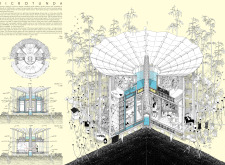5 key facts about this project
The architectural design features a circular form, a shape that promotes not only aesthetic appeal but also functional efficiency. This layout creates a dynamic flow among spaces, encouraging a sense of cohesion and community. The central area of the design acts as a communal hub, facilitating social interaction while private rooms extend outward, ensuring that occupants can enjoy both shared experiences and personal privacy. This thoughtful spatial organization is key to fostering a supportive living environment.
Material selection plays a crucial role in the project's overall impact. "Microtunda" employs sustainable materials, including locally sourced wood, bamboo, and recycled composites. These materials align with the project’s commitment to environmental stewardship while contributing to the local economy. The use of glass in the façades enhances transparency and visual connection with the natural surroundings, allowing ample light to filter through and creating an inviting atmosphere within the home.
One notable characteristic of "Microtunda" is its emphasis on bioclimatic design strategies. The orientation of windows is carefully considered to capture prevailing breezes, maximizing passive cooling and heating throughout the space. This strategic approach not only reduces reliance on mechanical systems but also underscores the project’s dedication to sustainability in architecture.
Another innovative aspect of the design is the incorporation of green spaces, particularly through an organic garden that surrounds the structure. This feature promotes biodiversity and supports urban agriculture, encouraging residents to engage with their environment actively. The garden serves as a vital resource for fresh produce while simultaneously enhancing the ecological footprint of the project.
Flexibility and adaptability are also central themes within "Microtunda." The interior spaces are modular, allowing residents to modify layouts based on their evolving needs. This responsive design philosophy ensures that the architecture remains relevant over time, accommodating various lifestyles and functions as they emerge.
The community-oriented layout is designed to foster social interaction, positioning communal gathering areas strategically while still providing secluded spaces for individual activities. This balance between collective and private spaces is essential in addressing the diverse needs of residents and creating a foundation for a supportive community.
In totality, "Microtunda" exemplifies a nuanced approach to modern architecture, merging aesthetics with practicality and sustainability. The careful integration of design elements, materiality, and layout showcases a commitment to living in harmony with the environment while facilitating strong community ties. By exploring the project presentation, readers can gain further insights into the architectural plans, sections, designs, and ideas that shaped "Microtunda," allowing for a deeper appreciation of its thoughtful execution and the principles that underpin its design.























